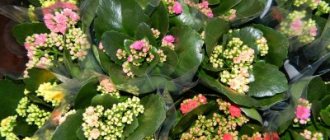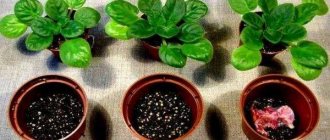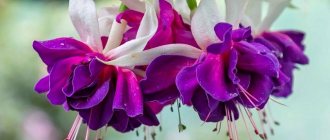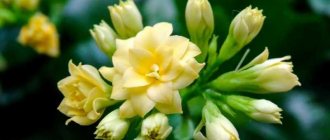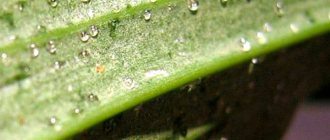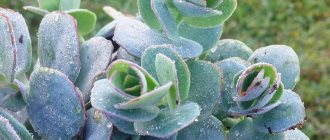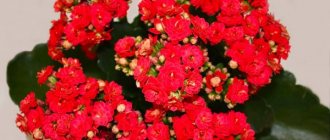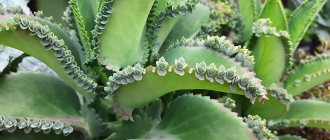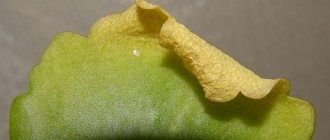Kalanchoe is one of the tropical exotic flowers that came to us from South America and Africa. It has long earned its popularity due to its beautiful flowering and medicinal abilities. In nature, Kalanchoe is represented by many varieties and varieties that belong to the group of succulents. In our article we will tell you about the most popular varieties, and also give some tips on growing them in your apartment.
Kalanchoe Kalandiva
This type of plant belongs to the Crassulaceae. It is considered very low maintenance. It only needs sufficient lighting, regular watering and a location away from drafts and direct sun exposure. The intensity of Kalanchoe flowering depends on the duration of the lighting period. Flowers of this species are beautiful inflorescences on medium-length peduncles. Flowers can be red, yellow, orange, pink, purple and others, depending on the variety. Flowering continues for several months. Kalanchoe itself is a small shrub with a thick trunk covered with beautiful fleshy leaves. The surface of the sheet can be glossy or velvety. This plant grows up to 30 cm in height.
Since this type of Kalanchoe was produced by man by crossing several varieties, you will not see it in nature. The basis for breeding this variety was Kalanchoe Blos Ferida, which combines several varieties that differ in flower color. Flowers of this species can be red, purple, white, pink, bright orange, and also have a two-color color. All of them consist of four petals, but in 2002 a variety appeared with 32 petals, the appearance of which was similar to a small rose. The general appearance of the bush resembles a beautiful blooming velvet ball. The leaves are opposite, held on short petioles, have a dark green color and a rounded shape. Flowering begins in December and continues until mid-summer. Due to the fact that this species was bred artificially, it is very rarely susceptible to various diseases and the problems that arise during its cultivation are the result of improper care of Kalandiva.
Folk signs
By the appearance of deer antlers you can judge the attitude of strangers towards your home. If after the guest leaves the plant begins to wither, it means that the person is hostile to the owners. If the bush is completely destroyed, it is also going to harm you.
It is better not to give this succulent to newlyweds, as the couple will start having quarrels and misunderstandings. And for a married couple with many years of experience living together, a flowerpot with this Kalanchoe will come to the court, strengthening and refreshing the relationship.
Kalanchoe Degremona
One of the most popular indoor flowers that can be seen in many homes. Also known as Bryophyllum Degremona. This type of Kalanchoe was brought to us from Madagascar. It is a succulent plant with a strong, straight stem that becomes woody at the base over time. The leaves are located on the stem opposite each other, which are attached to the petioles, have a fleshy structure, dark green color and an elongated triangular shape. The back of the leaf plate is painted with pink-violet stains. Kalanchoe of this species belongs to the “viviparous” plants. It grows small full-fledged plants - “babies”, which are attached to the edge of the leaf, have 2-3 true leaves and an independent root system. Over time, the babies detach from the mother leaf, fall into the ground and take root. In this way you can quickly propagate Kalanchoe.
Kalanchoe Degremona is distinguished by large bell-shaped flowers of purple-pink color. Flowering begins in autumn and continues throughout winter, making this flower very popular among gardeners. When growing this plant, you should be careful about the watering regime, since if it is over-watered, the flower may get sick and die. Also, Kalanchoe does not like drafts and direct sun, the rays of which cause burns on its leaves and flowers.
Features of the plant
While the plant is young, it is erect, but over time it bends under the weight of the branches. So dissected Kalanchoe can be grown in a flower pot, hanging on the wall. Just don’t push it deeper into the room—sunlight is vital for your pet.
Kalanchoe dissected pleasantly differs from other fellows in its bright green, waxy hue.
Kalanchoe Pinnate
A distinctive feature of this species is that it is used in folk medicine as a medicine. Each type of Kalanchoe has some of its own healing properties, but Cirrus is endowed with them to the greatest extent. In addition, this plant has a very beautiful decorative appearance, allowing it not only to be beneficial as a medicine, but also to decorate your window. In the wild, you can see Kalanchoe pinnate in Southeast Asia or America. In the natural fauna, it can grow up to one and a half meters in height, but when grown indoors, it is a low shrub with an erect stem of a fleshy structure, which has a woody lower part. The leaves are large, elliptical in shape with wavy edges. The upper leaves are pinnately dissected, oval-shaped, dark green in color, and may have a red or yellow tint. This type of Kalanchoe is also “viviparous” and grows “babies” along the edges of the leaf. Flowering begins when the plant reaches two years. The flowers are large, pink-green in color, located on the tips of the shoots in paniculate inflorescences. Flowering occurs irregularly. After flowering, a leaflet is formed - this is a fruit that can be used to propagate this type of Kalanchoe. Growing such a plant at home is not particularly difficult. It is recommended to add complex mineral fertilizers to the soil and moisten the flower only after the earthen ball has formed. The plant does not like drafts and direct sunlight.
Home care
Like any other Kalanchoe, a dissected one will not tire you too much, since it does not impose any special requirements for care. Grows and blooms well with minimal maintenance.
Location and lighting
Laciniata requires bright sunlight for several hours a day. So the southern or western orientation of the windows is what you need. If you keep the flower on a northern windowsill, you will have to supplement it with a phyto-lamp in the cold season. But he is not afraid of the presence of batteries, since he is able to accumulate moisture inside the stem.
When winter is over, the plant should be gradually accustomed to light, otherwise brown spots may appear on the leaves - these are traces of burns. But it is also not necessary to keep it in partial shade all the time, since the ward will begin to wither.
Temperature
The succulent does not have any special requirements for indoor heat. In summer it feels great both at +18 degrees and at +28°C. In winter it is advisable to maintain +16-18°C. If the room is warmer, flower buds may not form. It could be a little cooler. But make sure that the thermometer scale does not fall below +10-12°C.
Watering
Dissected Kalanchoe should be watered as soon as the top substrate dries out. If the flowerpot is on a south-facing windowsill, add more water in summer. In general, you need to water very moderately. In winter, the intervals should be significantly increased. Just don’t try to stop feeding it with moisture, otherwise the plant will die. It is advisable to use soft, settled water. Pour a little into the pan - this will prevent droplets of liquid from getting on the leaves.
Air humidity
The green friend does not need high humidity. So there is no need to spray the air around the flowerpot and the leaves themselves. You can moisten the leaves of laciniata occasionally on a particularly hot day.
The soil
Dissected Kalanchoe should be planted in a substrate intended for succulents or cacti. If you want to make the soil mixture yourself, use the following proportions of ingredients:
- 30% turf;
- 30% leaf soil;
- 30% river sand with a coarse fraction;
- 10% vermiculite.
If you want something exotic, you can prepare this mixture:
- 40% universal primer;
- 20% coconut substrate;
- 20% vermiculite;
- 20% humus.
And a very unusual option:
- 40% light loam;
- 30% coconut substrate;
- 30% zeolite litter used for cat litter.
Feeding and fertilizers
Buy cactus food for your ward. Apply them no more than twice a month in spring and summer. In the autumn-winter period, stop feeding.
Transfer
While the lobed Kalanchoe is young, it will have to be replanted annually. An adult bush requires a similar procedure when the pot becomes too small. The capacity will need to be low, since this type of Kalanchoe has a poorly developed root system. The bottom of the flowerpot should be lined with a 4-5 cm layer of expanded clay or pebbles.
Remove the bush from the old flowerpot along with the earthen lump, place it in a new pot, add a layer of soil, making a depression at the level of the neck. Add fertilizer. To adapt to a new place of residence, the flower will need 1-2 weeks.
Trimming
If you notice that the bush has become very elongated and the leaves have become thinner, prune it. Remove long stems (they can be used as seedlings). Get rid of faded and aged parts.
To preserve the decorative appearance of the laciniata for as long as possible, be sure to pinch the top in the summer.
Kalanchoe Benta
This type of Kalanchoe differs from others in its ability to accumulate moisture inside the leaves. This way it builds up moisture reserves and the leaves have a fleshy, thick texture. This property allows the plant to be moistened extremely rarely, and the juice accumulated in the leaves has a wide range of healing properties. The appearance of the plant is a highly branched large shrub that grows up to one meter in height when grown indoors. The leaves on the trunk are large, have an elliptical shape and are arranged in 6 pairs. Kalanchoe Benta blooms with snow-white flowers, which are collected in umbrella inflorescences. The flowers have obovate petals. Flowering begins in mid-spring and lasts for a month. In order to prolong the flowering period, as well as to help the plant regain its strength after it, you should feed the Kalanchoe with complex mineral fertilizers.
How to properly care?
Watering for Kalanchoe Laciniata should be moderate. We monitor the condition of the top layer of the substrate - when it dries completely, watering is required.- In summer, on especially hot days, we water 2 times a week in small doses.
In winter, we reduce watering, once every 7-8 days is enough; Kalanchoe Laciniata can get sick if over-watered, and is prone to rotting of the trunk and leaves.
- Temperature .
Kalanchoe Laciniata tolerates heat well. The temperature in summer is up to 28 - 30°C, in winter the required air temperature is 12 - 15°C. The most optimal temperature for keeping a flower is 17 - 18°C. Beware of overheating the air; if you keep Kalanchoe Laciniata at high temperatures, flower buds will not form, and you most likely will not see flowering. But the flower should not freeze, this causes the leaves to drop. - Fertilizer is best combined with watering. In summer, it is advisable to fertilize with mineral fertilizers; once every 6–8 days is enough, and any organic fertilizers should be applied no more than once every 14–16 days.
We water only with settled or purified water. Water can be poured into a tray so that it does not fall on the leaves.
With a lack of moisture, Kalanchoe Laciniata loses its leaves. Shriveled leaves are a sign of lack of watering. But even on summer days the flower does not require spraying.
Kalanchoe Blossfeld
This type of Kalanchoe is one of the most popular plants grown at home. He was loved for his low maintenance requirements and beautiful appearance. This bush grows up to 40 cm in height, has a very compact shape and a wide range of flower colors. In addition, its leaves have healing properties, which are used in folk medicine for healing wounds and as an anti-inflammatory agent. Begging for such a plant will not cause you much trouble. You just need to periodically fertilize, prune and moisten it. This species also stores moisture in its leaves and can tolerate periods of drought well. When grown in a location with indirect sunlight, Kalanchoe will provide you with flowers for a long period. In the nature of Madagascar, where this Kalanchoe comes from, it is found only with red or orange flowers. However, based on them, many varieties with multi-colored colors were bred. In order to get abundant flowering, experienced flower growers advise cutting off flower stalks immediately after the flowering period. This procedure stimulates the formation of buds for subsequent flowering. When the Kalanchoe has completely bloomed, it is trimmed to the first leaves and the watering periods are reduced. This will provoke the formation of new buds and rapid subsequent flowering.
Is there any harm
For all its positive properties, Kalanchoe can cause harm. Succulent juice should not be used in the following cases:
- for oncology;
- for liver damage, hepatitis;
- if you are allergic to Kalanchoe juice;
- for joint diseases.
It is necessary to take products based on Kalanchoe juice with the approval of a doctor. Be sure to follow the dosage. Taking too much of the medicine will cause diarrhea or heartburn. When used externally, the juice can damage the skin and mucous membranes.
Kalanchoe Bukhara
This species is a medium-sized subshrub native to Madagascar and Southeast Asia. This species is distinguished by a thin, weakly branched trunk, which is not covered with leaves in the lower part. When grown indoors, it does not reach a height of 40 cm. The stems are covered with olive-green wedge-shaped leaves with wavy edges. The upper part of the leaf blade has a gray waxy coating and slight pubescence. Flowering of such Kalanchoe is observed very rarely. It blooms with small pale yellow flowers collected in loose inflorescences. The plant is prone to elongating shoots, so it needs to regularly shorten the top. Caring for the plant involves infrequent watering and plenty of light during the flowering period. Kalanchoe Bukhara is propagated by cuttings, apical stems or using leaves.
Diseases and pests
Often, harmful insects show interest in deer antlers. So you need to monitor the condition of the bush and take urgent measures if pests have settled.
- Shield. Appears as a sticky gray coating. Due to the attack of a small pest, flowering stops. Carefully remove insects by treating the leaves with alcohol diluted with water. For preventive purposes, it is recommended to repeat the procedure after 10 days.
- Powdery mildew. Attacks the plant in case of waterlogging and excess heat. Characterized by white spots and an unattractive coating on the leaves. Reduce the room temperature and treat the patient with a fungicide.
- Mealybug. More often than other pests, Kalanchoe laciniata attacks. If you notice whitish wax balls, immediately treat the affected areas with alcohol and insecticide. You can also try spraying with mineral oil.
- Ticks. They leave yellow dots on the leaves. If you do not treat the affected areas with an insecticide, the plant will dry out.
- Aphid. It looks like green dots occupying the stem and leaves from below. If the problem is detected in time, a soap solution will be enough. If the disease is advanced, you will have to use insecticides.
Kalanchoe tomentosa (cat ears)
This species is a medium-sized subshrub, covered with fleshy leaves with thick whitish fluff. The leaves are gray-green with brown tips. Requires the same care as other crassula plants. This plant got its name because of the decorative leaves, which are covered with thick fluff and resemble the ears of a cat. The flower grows up to 30 cm in height, has weakly branching, erect stems, which after a while become semi-lignified at the base. The leaves are green, elongated, with light brown teeth along the edges. It blooms with purple-red flowers collected in umbellate inflorescences. When grown indoors, flowering is extremely rare.
Recommendations from experienced plant growers
Some tips for growing Kalanchoe from experienced gardeners:
- You should not put Kalanchoe in a plastic container. Moreover, metal-plastic windows can also negatively affect crop growth. It is not always possible to place the tree of life away from plastic windows. But if this succeeds, the Kalanchoe will thank the grower with abundant flowering and rapid growth.
- The succulent blooms from February to March, but it can also be grown in greenhouses. Then flowering can be achieved at the very beginning of winter. The grower must provide the plant with bright lighting, regular feeding and proper watering.
- If it is not possible to maintain the room temperature above 10 C°, the Kalanchoe needs to be additionally illuminated and warmed with lamps.
Among the numerous varieties of Kalanchoe, there are both decorative and medicinal varieties. This culture is considered hardy and unpretentious in care, which is why plant growers like it so much. Kalanchoe is a plant with powerful energy, gives a person confidence in his abilities and keeps peace in the family.
Kalanchoe Marble
This is a succulent plant, which is also known as Somali or large-flowered Kalanchoe. This species came to us from Ethiopia. In nature, it occurs as a subshrub about half a meter high. The stems are decorated with dark green leaves, which over time acquire a gray tint and brown or lilac spots. The leaves have an elliptical shape, narrowed at the base. The edges of the sheet contain a notch. Flowering begins in the second half of spring and lasts up to two months. During this period, the bush is covered with snow-white fluffy flowers. This species does not require special care, but requires infrequent watering and cultivation in sufficient light. Propagated by cuttings, leaves or apical shoots.
What to do with the flower after flowering?
After the bush fades, it is necessary to help it recover. To do this, first of all, the flower stalks are carefully trimmed.
It is also recommended to fertilize and shade the bush for several days. If you leave it in bright light, new buds will begin to form, which will be small and not very expressive.
Large-flowered Kalanchoe
It can be seen in nature in India. It is a semi-shrub plant reaching a height of up to 50-60 cm. The stems are covered with elongated leaves that can acquire a red tint when grown under active sun. This Kalanchoe is distinguished by pastel yellow flowers, collected in umbrella inflorescences, which form in late spring and release a pleasant, subtle aroma. It is grown at home according to the same rules as most types of Kalanchoe.
Beneficial features
Juice is extracted from the fleshy leaves of Kalanchoe. It is used both in home and official medicine. Compresses and lotions from this miraculous remedy help with the following problems:
- non-healing wounds;
- sunburn;
- trophic ulcers;
- boils.
Kalanchoe juice helps with runny nose in children and adults. It is instilled into the nasal passages.
Kalanchoe has the ability to kill harmful microbes that fly in the air. Therefore, it is useful to place a tree of life in every room.
Kalanchoe paniculataflora
This species is a herbaceous perennial that grows up to 60 cm in height. The shoots are covered with elliptical leaves, narrowed at the base. The leaf width is about 6-7 cm, the length is about 15 cm. The density of the crown increases at the base of the trunk. The apical leaves are small in size and grayish-white in color. This type of Kalanchoe is “viviparous” and forms “babies” along the edges of the leaf plate. Flowering begins in May with medium-sized bright yellow flowers. Likes to be grown in fertile soil on south-west windows.
Reproduction
The easiest way to obtain new Laciniata specimens is through cuttings. Beginner color lovers are recommended to use this method. But this type of Kalanchoe can also be propagated by children and seeds.
Propagation by cuttings
When transplanting Kalanchoe dissected, select large shoots of at least 6 cm. Cut them off, capturing the aerial root. Let the future seedling dry. After this, you can plant it in a loose, moist substrate, sand or agroperlite. You can also germinate the cuttings, obtaining roots, in a glass of water.
Propagation by seeds
Seeds are planted from January to March. Lay them on top of light deciduous soil, moisten and lightly press down. Cover with plastic film, glass or a sheet of paper. Germination should be done in a cool room with a temperature of +16-18 degrees. Every day - morning and evening - the shelter must be removed for ventilation, turning it over to the other side.
Make sure that the crops do not dry out by regularly moistening them with water at room temperature. After a month, plant the seedlings in a larger box. Keep it under cover for a couple more days. As soon as you see the first shoots, do not cover anymore.
Wait for a few leaves to appear and transplant into small pots 7 cm in diameter. When the seedlings take root, pinch the top. In mid-summer, repeat the procedure to form a beautiful bush.
In August, transfer to other flowerpots. Do this carefully, trying not to destroy the lump of earth with intertwined roots. Your plants should bloom in about a year.
Kalanchoe Flame
This variety is a perennial herbaceous plant of medium height. Often found in nature in Somalia. Its height varies up to 35-40 cm. The stems are decorated with oval small leaves, broadly rounded on one side. It blooms with orange or red flowers, forming umbrella-shaped inflorescences. They are grown in the same conditions as other types of this plant.
Soil requirements
It is best to purchase the substrate in a store , marked for succulents or cacti.
For the first option you will need:
- turf soil - 1 part;
- leaf soil - 1 part;
- coarse river sand – 1 part;
- vermiculite - 1/4 part.
You can also use:
- universal primer - 2 parts;
- coconut substrate - 1 part;
- vermiculite – 1 part;
- humus - 1 part.
Another substrate option:
- light loam - 1 part;
- coconut substrate - 1 part;
- zeolite litter for cat litter – 1 part.
Important: you can add pieces of birch charcoal and humus to the substrate. Drainage from expanded clay medium pieces is required.
